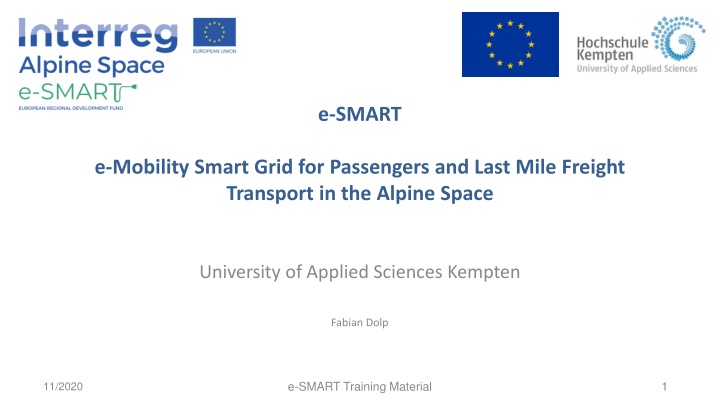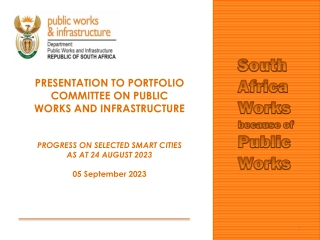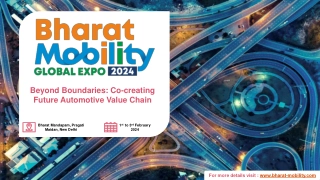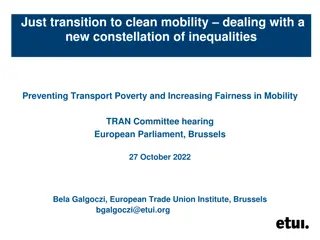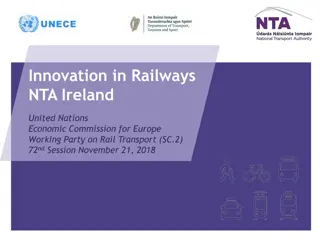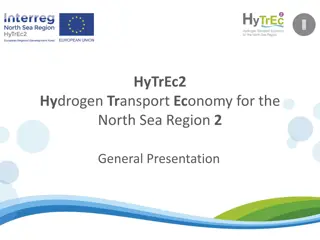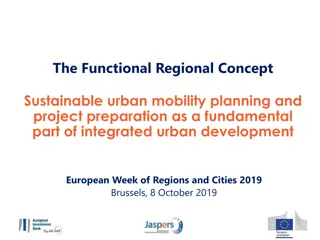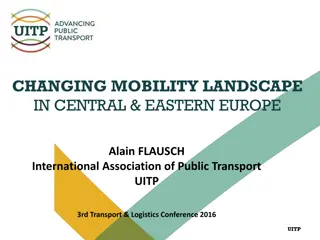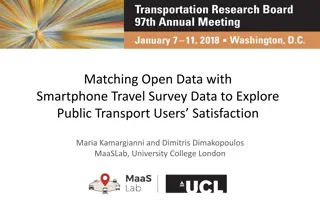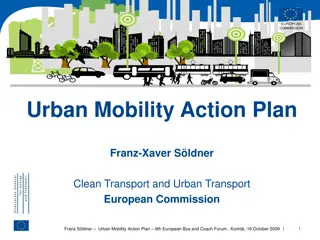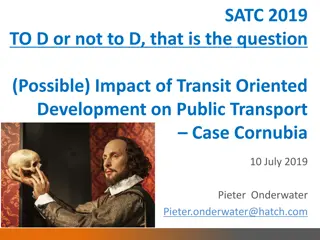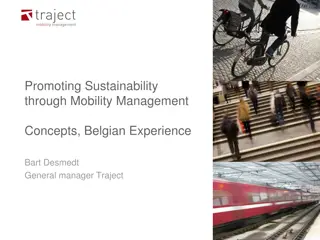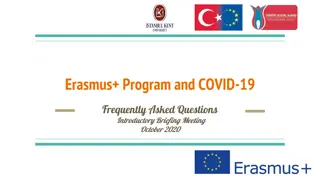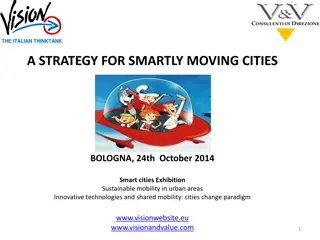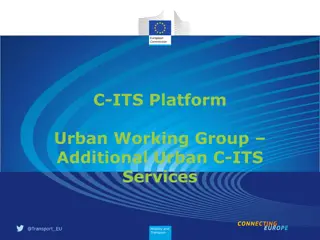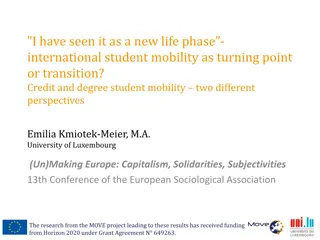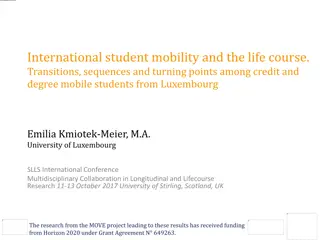e-SMART Project: Integrating E-Mobility in Alpine Space Public Transport
The e-SMART project focuses on integrating e-mobility into last-mile logistics and public transport in the Alpine Space region, emphasizing benefits like reducing emissions and improving air quality. The project aims to inform decision-makers and planners on the advantages of moving towards a more environmentally friendly public transport system, offering insights on factors driving e-mobility adoption and tips for successful integration.
Download Presentation

Please find below an Image/Link to download the presentation.
The content on the website is provided AS IS for your information and personal use only. It may not be sold, licensed, or shared on other websites without obtaining consent from the author.If you encounter any issues during the download, it is possible that the publisher has removed the file from their server.
You are allowed to download the files provided on this website for personal or commercial use, subject to the condition that they are used lawfully. All files are the property of their respective owners.
The content on the website is provided AS IS for your information and personal use only. It may not be sold, licensed, or shared on other websites without obtaining consent from the author.
E N D
Presentation Transcript
YOUR LOGO e-SMART e-Mobility Smart Grid for Passengers and Last Mile Freight Transport in the Alpine Space University of Applied Sciences Kempten Fabian Dolp e-SMART Training Material 1 11/2020
E-Mobility in Local Public Transport The e-SMART project deals with the integration of e-mobility into last-mile logistics and public transport in Alpine Space, especially in Italy, France, Germany and Slovenia. In doing so, e-Smart wants to inform political decision-makers, transport planners, mobility officers in the private and public sector and all interested parties and accompany them in the integration of e-mobility with all associated components such as infrastructure and network compatibility. For this purpose, several different "trainings" were developed within the framework of e- SMART and are now made available. In this training, the e-SMART consortium would like to offer answers to the following questions: 1. Why it is worthwhile to rely your region on e-mobility in public transport? 2. Which factors drive e-mobility in this area? 3. Which tips are helpful when integrating e-mobility into public transport? 2 e-SMART Training Material 11/2021
1. Why it is worthwhile to rely your region on e- mobility in public transport? 25% of all greenhouse gas emissions in Europe are currently due to transport, of which about 8% (per passenger and kilometer) are due to public bus transport1. This is another reason why public transport should be modernised and organised in a more environmentally friendly way. There are a number of advantages to be gained from operating a low-emission or, in the best case, climate-neutral public transport system: Reduction of traffic-related CO2 emissions Reduction of fine dust emissions Reduction of traffic noise Improvement of the quality of air Wthe citizens Improvement for the image of the city and region 3 e-SMART Training Material 11/2021
2. Which factors drive e-mobility in alpine space? The adoption of e-buses is driven by various market, policy and fiscal factors, and the balance varies by country and city. The following factors are considered particularly significant: 2.1 2.2 2.3 2.4 2.5 2.6 Legislation Renewable energy Technology Policy priorities Market economics Tax policy e-SMART Training Material 4 11/2021
2.1 Legislation Paris Agreement/ COP26 Glasgow: (a) Limiting the increase in global average temperature to well below 2 C above pre-industrial levels; efforts to limit the temperature increase to 1.5 C above pre-industrial levels. This should significantly reduce the risks and impacts of climate change; (b) Increasing the capacity to adapt to the adverse effects of climate change, promoting resilience to climate change, and promoting development that is associated with low greenhouse gas emissions while not threatening food production; (c) Compatibility of financial flows with a pathway towards low greenhouse gas emissions and climate resilient development.2 Clean Vehicle Directive: For the first time, the law sets binding minimum targets for low-emission and zero-emission passenger cars as well as light and heavy commercial vehicles, especially for buses in public transport, for public procurement. The requirements will apply from 2 August 2021 and oblige the public sector and, for individual services, also a selection of certain players organised under private law (e.g. postal and parcel services, city cleaning) to ensure that some of the vehicles purchased must be low-emission or zero-emission in the future.3 National, regional and city resolutions: For some nations, regions and cities, the decisions and guidelines adopted at the transnational level did not go far enough. Thus, within these structures, more ambitious goals were adopted in the corresponding instruments Access restriction policies: As a rule, access restrictions or closures aim at traffic calming and area upgrading in the sense of an increased quality of stay. For example, commuters from certain parts of the city can be shifted to public transport.an essentially distinguishes between two concepts of direct access restriction: o Pedestrian zones (ban on all motor vehicles with limited permission for delivery traffic at off-peak times). o Environmental zones (ban for a part of motor vehicles with special characteristics). In the urban area of an environmental zone, access for passenger cars that do not meet certain exhaust emission standards is prohibited. This measure is primarily intended to reduce particulate matter pollution in inner cities and improve air quality. e-SMART Training Material 11/2021 5
2.4 Policy priorities In order to achieve the decisions made at global and European level to meet the climate targets, a shift from individual mobility to the use of public transport is necessary. In doing so, the public offer should be expanded and made more attractive for all users. At the same time, European public transport is to be made sustainable and emission-free. Several major European cities, including Paris and London, want to have established an emission-free transportation system by 2050. The use of fully electric buses in local public transport is seen as a key component of this. Advantages of using all-electric buses: Reduction of traffic-related CO2 emissions. Reduction of fine dust emissions Reduction of traffic noise Improvement of the quality of air and life Improvement for the image of the city or region Training Material 6 11/2021
Renewable energy 2.2 Scale and pace of renewable energy deployment Currently, the share of renewable energy in Europe is about 20%. The EU has set itself the goal of becoming climate neutral by 2050. As a first step, greenhouse gas emissions are to be reduced by at least 55% by 2030 compared to 1990 levels. Since energy accounts for about 75% of EU-wide greenhouse gas emissions, decarbonisingEurope's energy systems is a major goal. To this end, the share of renewable energies is to be raised to 40% by 2030, in addition to increasing energy efficiency. This will reduce resource consumption, reduce energy imports, reduce energy-related energy and promote security of supply as well as technical innovation. The larger the share of renewable energies becomes, the greater the importance of storage options to match the fluctuations in energy production to the fluctuations in energy consumption and thus establish security of supply. From this point of view, the importance of electrified public transport also increases, as the vehicles can buffer the load and act as energy storage.4 This allows the operator of the vehicle fleet to play an important and decisive role in the energy transition. 7 e-SMART Training Material 11/2021
2.2 Renewable energy Grid (smart grid) The majority of renewable energy comes from solar and wind power. These are dependent on the weather and are thus subject to large fluctuations, which in turn can lead to a short-term oversupply or undersupply of electricity locally. In view of these innovations, grid operators face a challenge. The so-called smart grid technology offers solutions here. Electric vehicles also create new opportunities, because they not only represent an additional type of consumer, but also a possibility to act as buffer storage and thus stabilise the power grid. The control power in the energy grid must be kept constant. A grid operator can remedy problems with the power supply by building stronger lines and transformers. However, this involves high investments and is not very economical in times of low utilisation.This grid expansion can be avoided with a smart grid. By using communication technology, smart grid components coordinate electricity generators, consumers and storage. For example, a digital electricity meter communicates a household's consumption with the grid in real time. With the help of this information, power plants can precisely adjust their electricity production to the current demand. Load shifts can also be used to compensate for fluctuations in the grid. For example, a modern refrigerator or heat pump is more likely to switch on when there is an oversupply of electricity. If, for example, a strong wind front produces excess electricity on a given day, it can be stored. At the moment, this is done with the help of stationary electricity storage systems. This is precisely where electric vehicles with their batteries offer new potential. e-SMART Training Material 8 11/2021
2.2 Renewable energy Energy markets, ability for net metering In addition to the conversion of energy sources to renewable energy generation, the electricity market must also adapt to the new conditions. The use of renewable energy systems entails a number of special features. One measure is net metering (or net energy metering, NEM), an electricity billing mechanism that allows consumers who generate all or part of their own electricity to consume that electricity at any time, not just when it is generated. This is particularly important for renewable energy sources such as wind and solar power, which cannot be disconnected (unless they are connected to storage facilities). With monthly net metering, consumers can use solar power generated during the day at night or wind power generated on a windy day later in the month. With annual net metering, a net kilowatt hour (kWh) is carried over to the following month, so solar power generated in July can be used in December or wind power from March can be used in August. Another measure is the interconnection of several electricity grids across national borders. The transnational grids created in this way can balance peak loads across Europe and ensure security of supply throughout Europe. These developments increase the importance of e-vehicles in public transport, among other things, the technical advantages in the combination of new energies and the technical possibilities are a decisive factor here. e-SMART Training Material 9 11/2021
2.2 Renewable energy Presence of market-based energy providers (especially private utilities): Competition between flexible generation, flexible demand and storage also promotes innovative business models in the electricity market: free pricing on the wholesale electricity market ensures investments in the required generation capacities, for example in the form of renewable energy plants. The capacities that are demanded by customers are held in reserve - no more and no less. This is the key difference to state capacity procurement mechanisms, where the state simply determines the amount of capacity to be held in reserve. This often results in expensive overcapacities. In the so-called "energy-only market", on the other hand, security of supply is ensured cost-effectively via the market. Within this system, e-mobility can play a major role in controlling the energy flows and thus assumes a central role.5 e-SMART Training Material 10 11/2021
2.3 Technology Bus development: The technical development of e-buses is progressing steadily, not least due to the preceding and following factors that drive the integration of e-mobility into public transport through e-buses. Bus models have already been tested under real conditions and were able to cover more than 550 kilometers without intermediate charging under realistic conditions.6With increasing competition among the manufacturers, the technical development of the vehicles is also being driven forward and the vehicles will become even more efficient than they already are today. Battery improvements: Battery research is at the heart of the technical development of e-mobility, and large electricity storage systems are also needed to achieve the climate targets and the energy transition. Thus, e-mobility and ultimately also the development of e-buses is benefiting from the general spirit of optimism. In no other technical field have so many patents been filed in such a short time in recent years as in electricity storage research.7 The greatest hopefuls are the solid-state battery, which promises shorter charging times, higher performance and more charging cycles without compromising quality, and smart batteries, which can supplement the public power supply network with "vehicle-to-grid (V2G)" and "vehicle-to-home (V2H)". Availability of street charging infrastructure: In contrast of e-vehicles in public transport is much more dependent on the existing infrastructure. This must function reliably and in line with demand in order to guarantee a smooth process flow. In the area of infrastructure for e-buses, there are a number of different charging systems and strategies. From the use of overhead lines to the construction of bus depots with inductive charging systems, there are many different options that allow precise adaptation to local conditions and challenges. Please find more information on this in the e-SMART Tactical Roadmap in chapter 2. e-Mobility. e-SMART Training Material 11 11/2021
2.5 Market economics Research suggests that demand patterns for e-buses largely reflect the general trend of cities towards electrification and new mobility business models and technologies, such as shared mobility and autonomous vehicles. Customer demand - primarily a combination of political, regulatory and cultural pressures - is largely driving e-bus markets in European cities. Economic considerations play a lesser role, as the total cost of ownership for e-buses remains significantly higher than for diesel vehicles. Nevertheless, market-specific factors must be right in order to drive the spread of e-mobility in public transport. The following factors are: Market price in the e-bus sector, availability and structure of diesel Natural Gas/CNG and electric energy Maturity of supply chain industry of e-buses Local skills and industrial base 12 e-SMART Training Material 11/2021
2.6 Tax policy One of the most important and effective instruments of state control over the development of national mobility is certainly taxes and state subsidies. Against the background of the adopted climate targets, which have already been partially translated into national law, the framework conditions for meeting the targets are also being created in terms of taxation. In addition, the willingness of the state to promote climate-neutral vehicles and mobility concepts is also increasing. Higher taxes on fossil fuels Lower taxes on electricity Capital subsidies for zero-emission vehicles e-SMART Training Material 13 11/2021
3. Which tips are helpful when integrating e- mobility into public transport? As already mentioned, the restructuring of public transport and the inclusion of e-mobility offers great potential that is currently only partially or hardly exploited. The following notes are intended to serve as a rough guide for responsible persons of any kind in the field of public transport. Conduct a feasibility study to understand the operational framework. Apply the "systems approach" to identify stakeholders and build collaboration at each stage of the project (planning, installation, and operation) Know local regulations and policy framework for efficient planning and installation process, avoiding delays (permits and connection points) Consider electric buses as part of a zero-emission mobility strategy, not as the only solution Identify the most appropriate solution based on the characteristics of the city and the requirements for bus operation(frequency, stops, central interchanges etc.). Planning of the additional buses according to the chosen strategy and technology and maintaining the service level Conversion of the fleet to all-electric vehicles based on the needs and strategy of the city and/or its electric mobility strategy (or equivalent) that provides the framework for the of the plan for the deployment of electric buses e-SMART Training Material 14 11/2021
3. Which tips are helpful when integrating e- mobility into public transport? Consideration of the physical impact in the city: design of charging points, space requirements in the city and space for electric bus depots. Develop a set of recommendations/guidance on the visual impacts of public transportation infrastructures (bus stops, charging stations, substations and transformers, etc.) on the public public realm have Consideration of strategic locations of bus depots for efficient operations Standardization of charging infrastructure and making it and interoperable for other bus operators and other e-mobility services Shared use of the electricity grid and charging infrastructure by bus companies and other e-mobility providers without affecting individual services Considering the long-term financial impact in terms of health benefits versus the financial cost of the system Sharing with experienced cities, knowing that there is no one-size-fits-all solution Exchange with experienced cities in the field of electrification of public transport, knowing that there is no one-size-fits-all solution. e-SMART Training Material 15 11/2021
YOUR LOGO Thank you for your attention Please also use the other training materials of the e-SMART project. e-SMART Training Material 16 11/2021
Sources 1. 2. 3. 4. 5. 6. 7. EU Commission Expert Group on Clean Bus Deployment; D2 Procurement and Operations https://ec.europa.eu/clima/eu-action/international-action-climate-change/climate-negotiations/paris-agreement_en (retrieved on 15.11.2021) https://www.europarl.europa.eu/RegData/etudes/BRIE/2018/614690/EPRS_BRI%282018%29614690_EN.pdf (retrieved on 15.11.2021) https://www.destatis.de/Europa/DE/Thema/GreenDeal/GreenDeal.html?nn=217532 (retrieved on 15.11.2021) https://www.bmwi.de/Redaktion/DE/Dossier/strommarkt-der-zukunft.html (retrieved on 15.11.2021) https://press.mantruckandbus.com/corporate/man-sets-the-standard-for-range-fully-electric-bus-breaks-the-550-kilometre-barrier/ (retrieved on 15.11.2021) https://www.tagesschau.de/wirtschaft/akkuforschung-batterien-101.html (retrieved on 16.11.2021) e-SMART Training Material 17 11/2021
